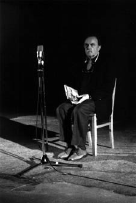|
Audible Light
installations
Place: Trafó Stúdió
A workshop for selected young composers of computer music from the class of Johannes Kretz (Universität für Musik und Darstellende Kunst Wien) and of Andrea Szigetvári (Franz Liszt Academy of Music, Budapest) aims to develop various interactive compositions and installations with laser light and sound projection. The long-term-experience of Johannes Kretz in formalizing of compositorial strategies, in programming of special purpose software and in the definition of a language for audio-visual interaction will guide the participants to shape their projects and create unique experience for the viewer/listener. Participating composers of the workshop from Austria: Matthias Kranebitter, Christoph W. Breidler, Fernando Riederer, Wei-Ya Lin, Robert Kellner Participating composers of the workshop from Hungary: Tamás Matkó, Ádám Siska, Máté Szigeti. The installations will be presented in the installation space (Trafó Stúdió) of the festival from the 15th of February until the end of the festival. |
|
|
|
Audible light installations
for children
Place: Trafó Stúdió
For Saturday and Sunday afternoon we offer a family program presenting laser-instrument installations composed specially for children (between 6 and 99 years) together with a simple explanation how to play the laser-beams. |
|
|
|
Alvin LUCIER
(USA):
I am Sitting In a
Room
Place: Trafó Stúdió
In the installation of Alvin Lucier :I am Sitting In a Room: the space acts as a filter; it filters out all of the frequencies except the resonant ones. It has to do with the architecture, the physical dimensions and acoustic characteristics of the space. The way it happens: "I am recording the sound of my speaking voice and I am going to play it back into the room again and again until the resonant frequencies of the room reinforece themselves so that any semblance of my speech, with perhaps the exception of rhythm, is destroyed. What you will hear then, are the natural resonant frequencies of the room articulate by speech. I regard this activity not so much as a demonstration of a physical fact, but more as a way to smooth out any regularities my speech might have." (Alvin Lucier) In the festival a real-time version of the piece will be presented with the help of a MAX/MSP programme. The first version will be recorded by the composer – Alvin Lucier – himself during a public performance. |
|
score:
I'm sitting in a room, for voice and
electromagnetic tape. Necessary equipment: 1
microphone, 2 tape recorders(2 Nagras in 1980),
amplifier, 1 loudspeaker.
Choose a room the musical qualities of which you
would like to invoke. Attach the microphone to the
input of tape recorder n°1. To the output of tzpe
recorder n°2 attach the amplifier and loudspeaker.
Use the following text or any text of any length:
Record your voice on tape through the microphone attached to tape recorder n°1. Rewind the tape to its beginning, trnsfer it to tape recorder n°2, play it back into the room through the loudspeaker and record a second generation of the original recorded statement through the microphone attached to tape recorder n°1. Rewind the second generation to its beginning and splice it onto the end of the original recorded statement on tape recorder n°2. Play the second generation only back into the room through the loudspeaker and record a third generation of the original recorded statement through the microphone attached to tape recorder n°1. Continue this process through many generations. All the generations spliced together in chronological order make a tape composition the lenght of which is determined by the lenght of the original statement and the number of generations recorded. Make versions in which one recorded statement is recycled through many rooms. Make versions using one or more speakers of different languages in different rooms. Make versions in which for each generation, the microphone is moved to differnts parts of the room or rooms. Make versions that can be performed in real time. RESULT: The space acts as a filter; it filters out all of the frequencies except the resonant ones. It has to do with the architecture, the physical dimensions and acoustic characteristics of the space. Every musical sound has a particular wavelength; the higher the pitch, the shorter the wavelength. Actually there's no such thing as "high" notes or "low" notes, we simply borrowed those terms from the visual world to describe something we didn't undezrstand. A musical sound as it is produced on an instrument, in a column of air or vibrating string, causes oscillations at a certain rate of speed. For ex, the A that an orchestra tunes to vibrate at 440 times per second and can therfore be considered faster than th middle C on the piano that vibrates at about 262 times per second. But as those sounds move outinto space they can be observed as various-sized wavelengths, so you can see how directly the dimensions of a room relate to musical sounds. If the dimensions of a room are in a simple relationship to a sound that is played in it, that sound will be reinforced, that is, it will be amplified by the reflections from the walls. If, however, the sound doesn't "fit" the room, so to speak, it will be reflectedf out of phase with itself and tend to filter itself out. So by playing sounds into a room over and over again, you reinforce some of them more and more each time and eliminate others. It's a form of amplification by repetition. Thinking of sounds as measurable wavelengths, instead of as high or low musical notes, has changed my whole idea of music from a metaphor to a fact and, in a real way, has connected me to architecture.(Every room has its own melody, hiding there until it is made audible). |

